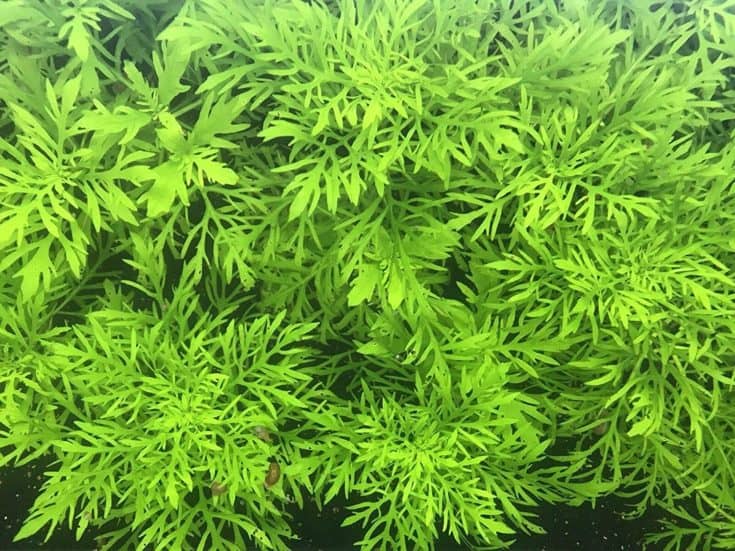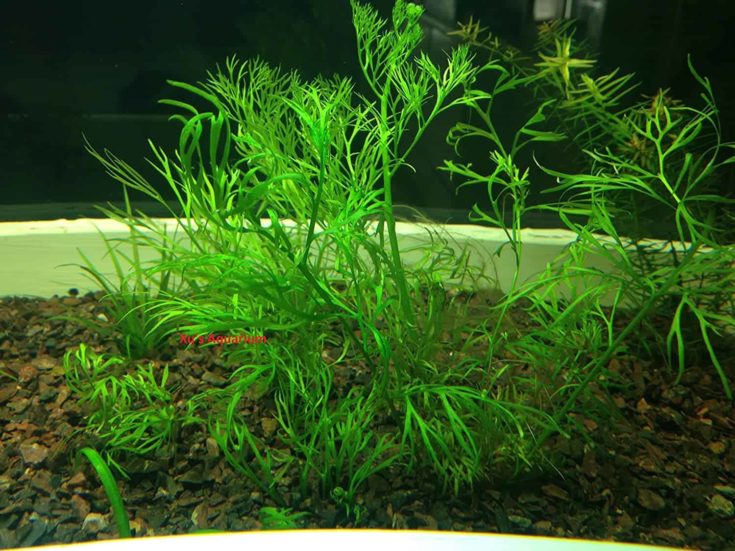Wisteria and Water Sprite are two popular freshwater aquarium plants. In folklore, a water sprite is an elemental entity that can breathe air and water and can also fly! But there’s nothing otherworldly about this popular freshwater aquatic plant.
You’ll find both these species of aquatic plants at your local fish store or for sale online, but which is the best? Or, are they about the same?
In this comparison article, we look at Water Sprite vs. Water Wisteria to see which species comes out on top!
Read on to find out the difference between Water Wisteria and Water Sprite.
What’s The Difference Between Wisteria and Water Sprite?
Water Wisteria is a flowering plant when it grows above the water, but Water Sprite is an aquatic fern that doesn’t produce flowers. Water Sprite is very bushy compared with the narrower leaves of Wisteria.
Wisteria is able to change its leaf structure, whereas Water Sprite cannot. Wisteria has clearly defined stems and roots, while Water Sprite has a central growing point or rhizomes.
Comparison Table
Water Wisteria

Flowering plant yes/no
Yes
Plant form
Narrow and less bushy
Morphology
Yes
Color
Bright green
Growth rate
Rapid
Tropical
Yes
Water Sprite

Flowering plant yes/no
No
Plant form
Dense and bushy growth
Morphology
No
Color
Bright green
Growth rate
Rapid
Tropical
Yes
Both Water Wisteria and Water Sprite are extremely popular with aquascapers. Although the plants appear similar at first glance, they are different species with different growing habits and forms.
If you want a very bushy plant that grows rapidly from a central growing point, Water Sprite is the best choice. However, if you want a plant that produces flowers when allowed to grow above water and is less dense in form with clearly defined stems and branches, Wisteria is the way to go.
Both species are hardy and grow in a variety of conditions that are commonly found in tropical fish tanks.
Now, let’s take a closer look at both these vibrant, beautiful aquatic plants.
Water Sprite
Water Sprite is often confused with Wisteria, although the two plants are not the same species, and they do have some notable differences:
- Water Sprite has the scientific name Ceratopteris thalictroides and the common names Indian Fern, Water Fern, and Indian Water Fern.
- As you can guess from some of its common names, Water Sprite originates in India, although small natural populations exist in Florida and as an invasive species in California.
- In nature, the plant grows in swamps, marshes, and other slow-moving, near stagnant bodies of water, including ditches and irrigation canals.
- The plant can handle hard water conditions, a wide range of temperatures, and even low levels of salinity.
- The plant’s growth habit is very bushy and dense.
- Water Sprite grows extremely quickly when given the right conditions, making it a problem in some areas where it’s regarded as an invasive species.
- Like Wisteria, Water Sprite is bright green in color.
Water Wisteria
- Water Wisteria has the scientific name Hygrophila difformis.
- Water Wisteria is found in India, Bangladesh, Thailand, parts of Malaysia, and Bhutan where it grows wild in rice paddies, marshes, and the like.
- If allowed to grow above the waterline, Wisteria produces flowers.
- Wisteria grows rapidly when given the correct conditions.
- The plant can change its leaf structure.
Comparison Of Growing Conditions
So, can you grow Water Wisteria and Water Sprite in the same aquarium? Do these plants like the same growing conditions? Let’s find out.
Water Sprite
Water Sprite is very easy to grow in most home fish tanks, rapidly reaching a size of up to 13½ inches.
The plant prefers a water temperature of between 66oF and 85oF, with a pH range of 6.0 to 8.0, and a water hardness of between 3 and 10 dKH.
Water Sprite can be grown as a floating plant or anchored in the substrate. However, the plant tends to uproot itself very easily, especially in a tank with a moderate to high flow, so it’s easier to grow Water Sprite free-floating unless you use plant weights.
As regards lighting, Water Sprite is content with moderate to low lighting, especially if you’re growing it as a floating specimen. CO2 is unnecessary for Water Sprite, but it does appreciate the addition of liquid fertilizer to the water.
Water Sprite – Problems
Probably the biggest problem I’ve encountered with Water Sprite is that it grows incredibly rapidly and puts out lots of leaves.
In fact, there’s such a quick turnaround that you’ll frequently find that your plant develops brown leaves. That’s to be expected with Water Sprite. Simply snip off the dead leaves to make way for new growth and to prevent the old leaves from decomposing in the tank and polluting your water.
Because of its phenomenal growth rate, Water Sprite can choke off other slower-growing plants. To prevent that, you’ll need to regularly thin out the Water Sprite.
Water Sprite Propagation
The easiest way to encourage the plant to propagate is to snip off a few leaves then let them float free. Roots will quickly form, and you have a brand new plantlet.
If you decide to use Water Sprite as a background plant, keep it away from power filter water intakes. The plant has delicate leaves and fragile stems that could be sucked into the filter intake, damaging the plant and clogging the filter, too.
Water Wisteria
Water Wisteria is also very easy to grow, reaching a size of up to 20 inches. For that reason, this plant species is not really well-suited to a nano tank.
The plant likes a water temperature of between 75oF and 82oF, with a pH range of 6.5 to 7.5, and a water hardness of between 2 and 8 dKH. So, you could grow Wisteria in a tank with Water Sprite, as they both like pretty much the same conditions.
Like Water Sprite, Wisteria can be grown as a floating plant or rooted in the substrate. Once the roots have become established, the plant doesn’t tend to float away like Water Sprite can. You can also grow Wisteria as a spreading carpet plant, provided that you plant it on its side so that the leaves grow flat across the substrate.
Water Wisteria will grow under moderate to high lighting and grows best with the addition of a liquid fertilizer or root tabs.
Water Wisteria – Problems
Water Wisteria doesn’t present many problems, aside from a few lost or dead leaves that you’ll need to remove from the tank before they start to rot and damage the water quality.
Water Wisteria Propagation
In nature, Wisteria self-propagates through producing new plantlets by shedding parts of the mother plant. The same thing happens in the aquarium, although you can take cuttings from the plant and set them wherever you want them in your tank.
Once the plant reaches its full height, cut off the top five inches from the stem and plant them in the substrate. The cuttings will quickly grow roots and develop into a brand-new plant. Note that the cuttings must have a few leaves so that the new plant can photosynthesize.
What Fish Can Live With Water Sprite?
Most fish species are fine living in a tank with Water Sprite. However, if you grow the plant floating free, you might need to thin it out fairly frequently if you have species that need access to the surface to breathe, such as gouramis and bettas.
Shrimp love to shelter among the leaves of planted Water Sprite, and snails don’t generally make a meal of the plant, so can safely be kept in a tank with it. Also, the plant’s leaves often trap scraps of food that inverts will happily feast on.
What Fish Can Live With Water Wisteria?
Water Wisteria is similar to Water Sprite in that it’s generally fine to keep with most fish species. Also, invertebrates love to hide among the lush leaves, foraging for scraps of uneaten food that drift down from above.
However, there are a few exceptions to that. Rainbowfish, Silver Dollars, and Goldfish might destroy the plants, and confirmed diggers like Oscars are best avoided, as they could uproot the plants.
Pro Tip
So, both plant species would do fine in a community tank with the likes of Corydoras catfish, tetras, Guppies, Gouramis, Barbs, and Swordtails. Some species of snails will make a meal of plants, but Assassin snails are a fairly safe bet if you want to keep a few mollusks to eat any algae growing in your tank.
In Conclusion
I hope you enjoyed our comparison of Water Sprite and Water Wisteria. If you did, please remember to share this article!
Both plants are similar in that they can be grown and propagated very easily in similar water and lighting conditions. Of the two species, Water Sprite is more prone to browning and can be tricky to keep anchored in the substrate. Both plants can be grown free-floating or rooted, and Wisteria can be used as a very attractive carpet plant, too.
Do you have Wisteria or Water Sprite in your aquarium? What kinds of fertilizers do you use to make your plants flourish, and which of the two species is your favorite?
Tell us in the comments box below!
Pearl Gouramis stay alot calmer when they have a water sprite network to lurk in
Those both looked like wisteria to me!I have grown water sprite before and usually has a leaf instead of a featherly leaf.Which is a lot nicer if you livebearers or bettas.I have been looking for the true water sprite!
Great article, love the way you laid out the page, with subject headings, main points and different colors. Easy informative reading.
Detailed comparison. I searched for this topic over the internet, & found your website. Here I found everything I needed. Thank you
Hi Alison!
I have been thinking so far that Water Wisteria & Water Sprite are the same plants because of similar appearance but after reading your comprehensive comparison, now I realize that they are quite different. Thank you for this informative post.